Have you ever rolled out a new rug and noticed the corners sticking up or waves running across it? It’s frustrating, and it can even be a little unsafe when you’re walking around. I’ve been there, and I know how much it can throw off the look of your space.
The good news is that you don’t need special tools or a professional to fix it. With a few simple tricks, you can get it smooth again.
In this post, I’ll show you exactly how to flatten a rug using easy, proven methods. You’ll also pick up tips people in the community swear by, so your rug looks neat and stays flat.
Why Rugs Curl, Wrinkle, or Buckle
Rugs don’t always stay flat, and there are a few common reasons why this happens.
- Fiber memory: Most rugs are shipped rolled or folded to save space. The fibers “remember” that shape, which is why corners stick up or edges curl when you first unroll them.
- Humidity and temperature: Changes in moisture and heat cause materials to expand or contract. In damp or humid areas, rugs can ripple or lift more easily.
- Traffic and furniture: Daily wear, heavy furniture, or moving items across the rug can cause shifting and uneven tension, leading to buckling.
- Cleaning: After a rug is washed, the fibers may dry unevenly. If not laid out properly, new creases can set in as the rug dries.
Sometimes brand-new rugs will relax and flatten on their own after a few days. But older, vintage, or washable rugs often need extra care to smooth out and stay flat.
Which Method Works Best for Your Situation?
Not every rug needs the same treatment. The best method often depends on how the rug was stored, the severity of the creases, and the type of rug you have. Use the guide below to match your situation with the most effective starting point.
| Situation | Best Starting Point |
|---|---|
| Just unrolled a new rug | Lay it flat for a day or two and let it relax. Add weights on the corners if needed. |
| The rug has stubborn waves or creases | Apply gentle heat using a hair dryer, an iron with a barrier, or short sun exposure. |
| The rug keeps curling on hard floors | Secure it with a rug pad, corner grips, or carpet tape to keep it in place. |
| Antique or high-value rug | Skip DIY methods and call a professional for safe steaming or stretching. |
This quick guide gives you a solid starting point. Once you know where your rug fits, you can move on to the detailed step-by-step methods that follow.
How to Flatten a Rug: Simple Methods that Work
Rugs often curl or wrinkle from storage, shipping, or daily use. The good news is that a few easy techniques like these can get your rug laying smooth, safe, and neat again:
1. Let It Relax (Safest)
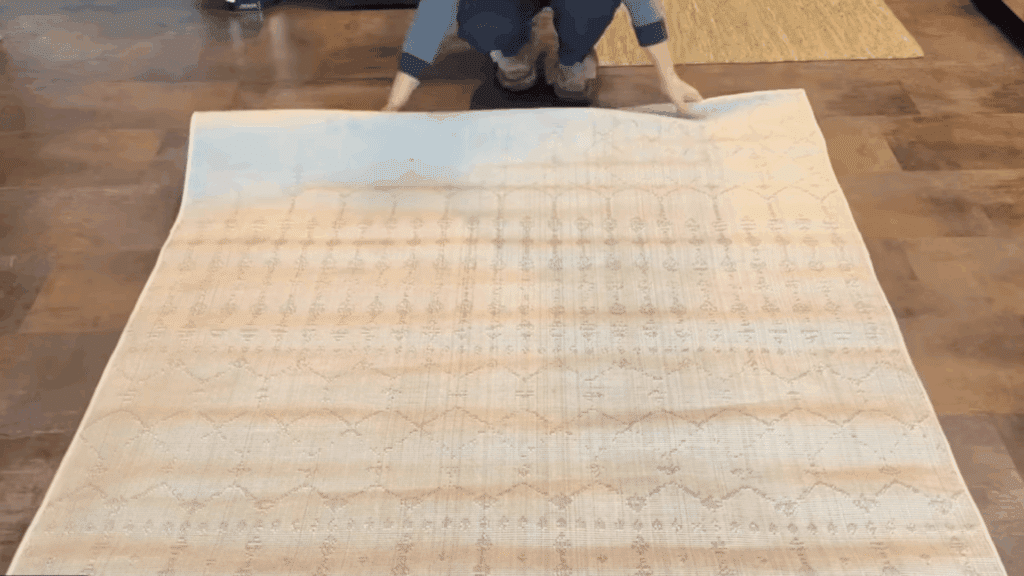
This is the simplest and safest way to flatten a rug without any tools. It just takes patience and time for the fibers to settle naturally.
- Unroll face down on a hard surface.
- Smooth by hand; leave 24–48 hours.
- Add books or a chair leg to each lifted corner.
Give it a day or two, and you’ll notice the rug start to lie flatter without extra effort.
2. Reverse-Roll
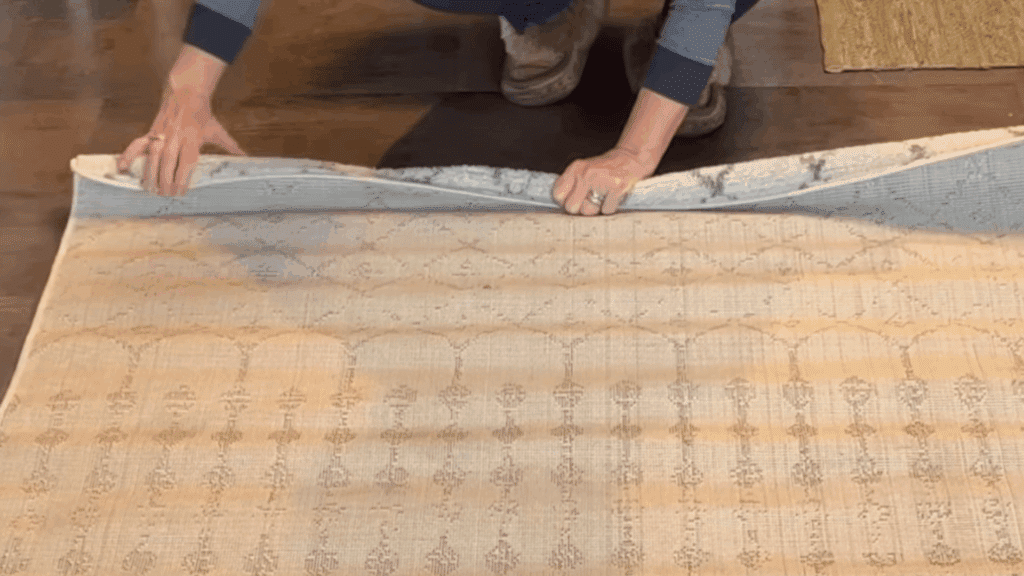
When your rug won’t stay flat, try rolling it in the opposite direction of the curl. This helps retrain the backing and fibers to lie flat again.
- Roll tightly in the opposite direction of the curl, and pile out.
- Strap with twine; leave 12–24 hours.
- Unroll and smooth; repeat once if needed.
If the rug still curls slightly, repeat once more. Most rugs respond quickly to this method.
3. Weights for Waves
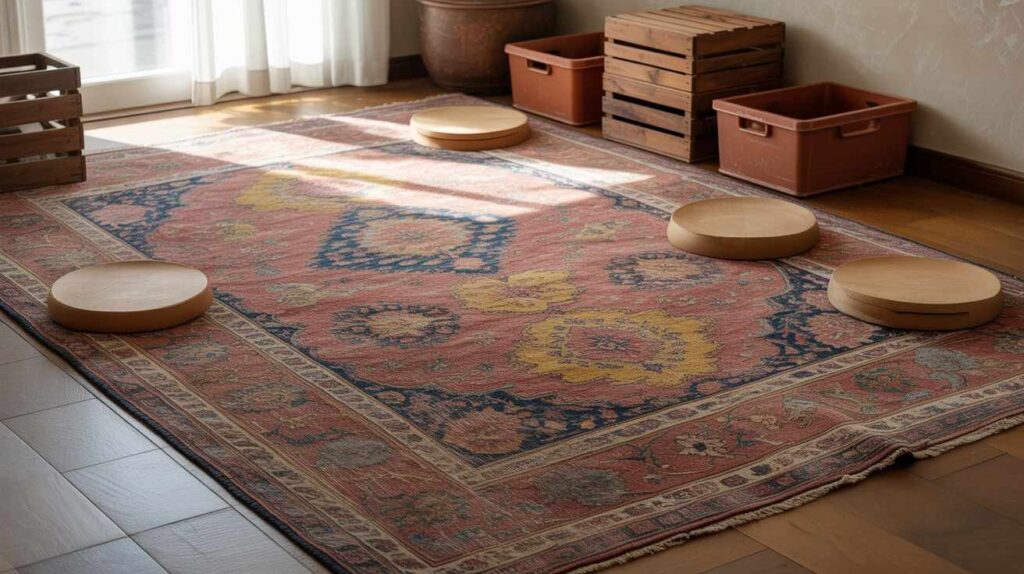
If your rug has ripples or raised spots, using even weight can press them out gently. This method is simple and safe for most rugs.
- Lay the rug flat; identify high spots.
- Place even weight (books, bins, furniture) across the bumps.
- Use a board or mat between the weight and the delicate pile.
After a day or two, remove the weights and check your progress, the waves should ease out nicely.
4. Hair Dryer (Low Heat)
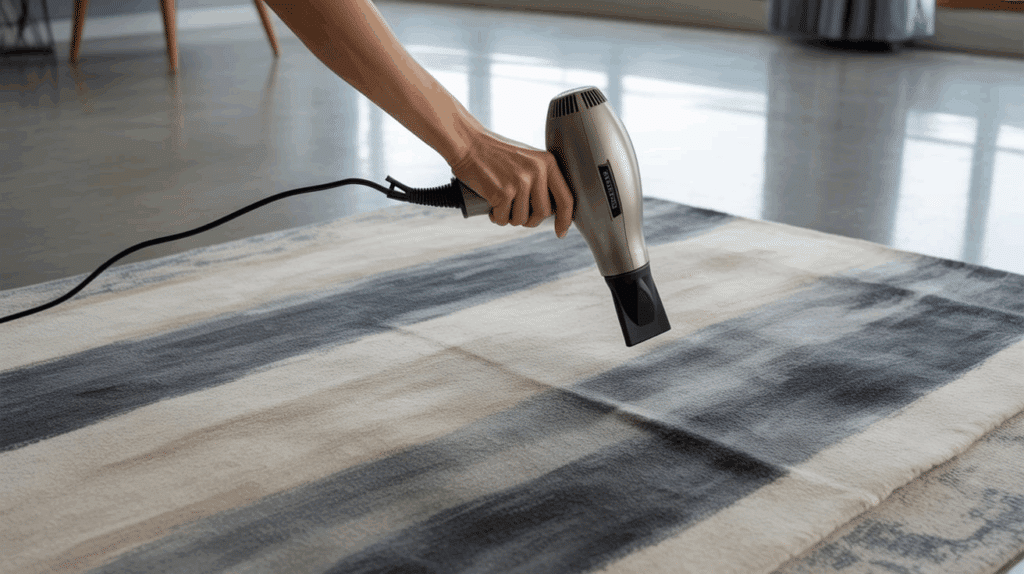
Heat can help loosen the rug’s fibers so they relax back into shape. Keep it low and gentle to avoid damaging the backing.
- Backing up. Hold the dryer 15–20 cm away.
- Sweep over creases on low/medium heat.
- Press flat with your hand or a board as it cools.
Let the rug cool completely before walking on it. This helps lock in its flatter shape.
5. Iron With a Damp Towel (Barrier Required)
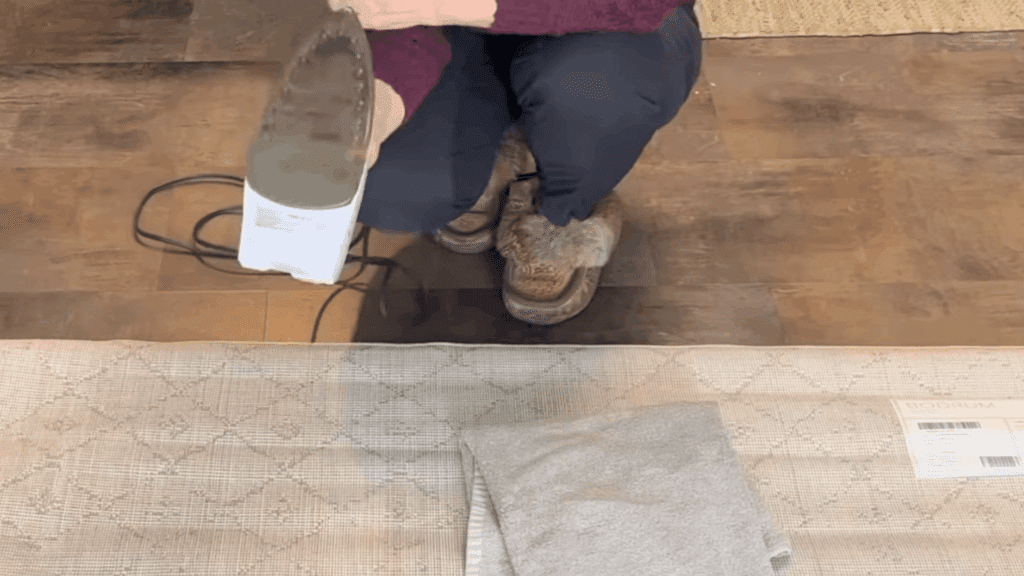
A little steam helps reshape stubborn folds, but you’ll need to protect the rug’s surface. Always use a towel as a barrier to prevent heat damage.
- Backing up. Lay a damp cotton towel over the crease.
- Iron on low steam; keep it moving.
- Lift, check, and repeat. Finish with weight as it cools.
You’ll notice results quickly, but don’t rush; gentle passes work better than heavy pressure.
6. Tape, Grips, or Pad (For Slip-Prone Corners)
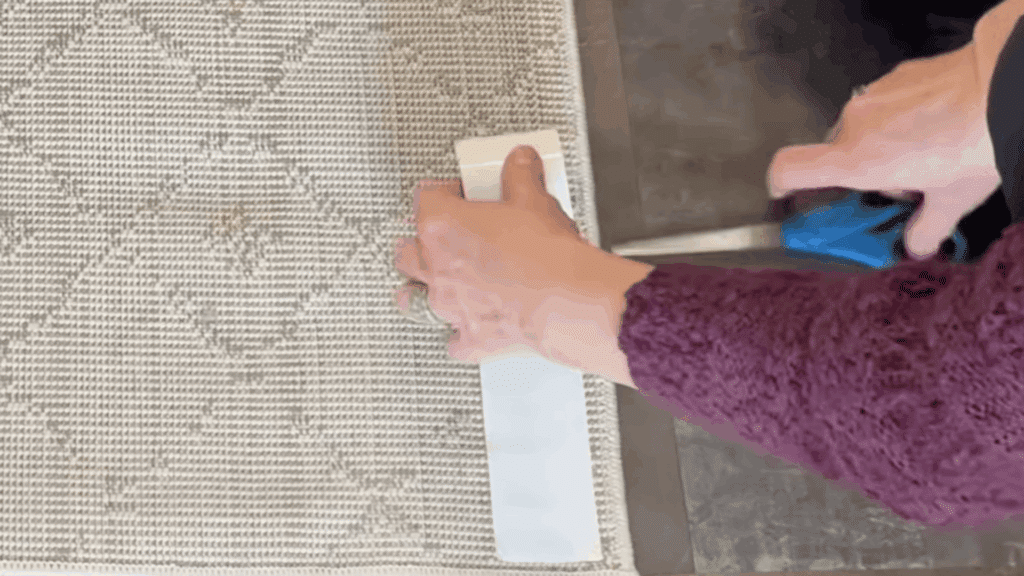
Once your rug is smooth, keeping it in place helps prevent future curling. These tools add grip and support to corners and edges.
- Clean floor; dry fully.
- Apply floor-safe double-sided tape to corners/edges or use corner grippers.
- Add a felt or felt-rubber pad slightly smaller than the rug.
This simple step helps your rug stay put, especially in high-traffic spots or near doorways.
When in doubt: Expensive, antique, or hand‑knotted rugs deserve a pro.
Why These Methods Work
- Reverse roll & weights: reset the rug’s fiber “memory” from storage.
- Heat & steam: soften fibers or backing so they relax, then set flat as they cool.
- Moisture: swells natural fibers briefly so they can be reshaped, then dry flat.
- Pads & adhesives: add friction and anchoring so corners can’t lift again.
Here is the Video By Our Upcycled Life for all the above methods:
Rug Flatening Method Comparison
Choosing the right method depends on your rug type, the problem, and how quickly you want results. The table below highlights the main options with their pros and possible risks.
| Category | Methods | Quick Note | Risks |
|---|---|---|---|
| Cheapest | Reverse roll, weights, short sun | No tools; slower results | Sun fading, pile crushing |
| Fastest | Hair dryer, steamer, iron + towel | Works in minutes | Heat can scorch, melt, or cause dye bleed |
| Safest | Relax naturally with light weights | Gentle on fibers | Takes several days |
| Longest-lasting | Rug pad + corner grips | Prevents future curling | Poor pads/tape may leave residue |
| Moisture tricks | Damp towel + iron, ice cubes, blocking | Good for washable/dented rugs | Moisture may warp or bleed dyes |
| Adhesives | Carpet tape, grips | Anchors edges quickly | Risk of sticky residue or floor damage |
| Washable shortcut | Low-heat dryer, then flat dry | Fast for small rugs | Shrinking or backing glue softening |
Each option has its place. Use quick methods if you need fast results, but invest in pads or proper storage for a long-term fix.
Rug-Specific Guidance to Prevent Damage
Not all rugs behave the same, and using the wrong method can cause damage. Here’s what works best for each type:
- Wool: Use only gentle steam and always test for colorfastness. Too much heat can shrink fibers or cause dye bleed.
- Polypropylene and other synthetics: Respond well to low heat, but keep tools moving. High heat may melt or deform the fibers.
- Cotton: Handles light steam and moisture fairly well. Smooth while warm, and let it dry flat to avoid ripples.
- Viscose, rayon, or art silk: Avoid water and steam altogether. Use weights and rug pads instead, since moisture can damage the sheen.
- Jute, sisal, and other plant fibers: Keep completely dry. Water can warp, brown, or weaken the fibers. Stick to weights, pads, or a short dry-heat session only.
- Tufted rugs with latex backing: Be careful with heat; glue in the backing can soften, crumble, or stick to floors. Use a felt pad and avoid strong adhesives.
- Washable rugs: Smooth them while damp, apply weights, and let them dry flat for the best results.
- Outdoor rugs: Short sun sessions help relax fibers, but bring them back inside before fading, mildew, or overheating sets in.
Adhesive & Product-Based Solutions for Rug Flatening
Sometimes a rug needs more than just weight or time to lay flat. In those cases, a few reliable products can make the job easier and give lasting results.
- Use carpet tape for quick corner and edge fixes, but always choose a floor-safe option to avoid residue.
- Stick corner weights or grippers to keep stubborn edges down, especially in high-traffic spaces.
- Add a rug pad for grip and cushioning, which also protects floors and prevents sliding.
- Try a wrinkle-release spray on lightweight fabric or washable rugs to relax creases as it dries.
These tools are inexpensive, easy to find online, and can be combined for even better results. Pick the option that matches your rug type and floor surface for the best outcome.
Community Hacks for Flattening Rugs
People in forums and discussions often share clever tricks for stubborn rugs.
For example, this Reddit thread on how to flatten a rug shows users recommending simple, low-cost fixes that actually work.
Common suggestions include using vinyl tiles or cardboard shims as DIY corner supports, applying painter’s tape for 24–48 hours to “train” rug edges, and resetting buckled rugs under furniture by lifting, smoothing, then replacing the furniture once the rug is flat.
These methods are inexpensive and widely reported to help with everyday rugs.
When to Call a Professional
Not every rug responds to DIY fixes. If your rug still won’t flatten after several attempts, or if it’s valuable, vintage, or delicate, it’s best to seek expert help.
Professionals use methods like steaming and stretching to restore rugs safely. They also test for risks such as color bleeding before beginning, which helps protect delicate fibers and dyes.
Calling a pro can feel like an extra step, but for high-value or antique rugs, it’s the safest way to achieve lasting results without damage.
Prevention & Long-Term Maintenance for Rug
Flattening a rug is one thing, but keeping it flat takes a little extra care. With a few smart habits, you can stop curls, ripples, and waves from coming back.
- Storage: Always roll rugs around a sturdy tube instead of folding. Wrap them in breathable covers to prevent creases and protect them from dust.
- After cleaning: Lay rugs flat until completely dry. This avoids moisture damage and helps keep edges from curling, especially on wood floors.
- Daily use: Place a quality rug pad underneath. Pads reduce slipping, add cushioning, and prevent fibers from bunching or curling over time.
By building these steps into your routine, your rug will stay smooth, safe, and looking its best for years to come.
Troubleshooting Tips
Sometimes, even after trying different methods, rugs can still be stubborn. Use these quick fixes when your rug won’t cooperate:
- Waves return in a day: Check humidity; run a dehumidifier and repeat weights.
- Corners still pop: Add corner grippers plus a felt pad trimmed 1–2 cm inside the rug edge.
- Rug creeps on another carpet: Use carpet-to-carpet underlay or a felt-rubber pad.
- Wavy after washing: Re-wet evenly with a mister, square edges, block, and dry with airflow. If it still puckers, call a pro.
- Backing turns sticky or leaves powder: Stop heat. Replace pad; consider professional cleaning or re-backing.
These tips cover the most common roadblocks. If none of them work, it’s usually a sign that the rug needs professional care.
Wrapping Up
Learning how to flatten a rug is mostly about finding the right method for your situation. Sometimes all it takes is a little patience, while other times you may need heat, tape, or a good rug pad. If the rug is valuable or fragile, calling a pro is the safest way to avoid damage.
I hope these steps give you the confidence to smooth out your rug and keep it that way. A flat rug not only looks better but also makes your space safer and more comfortable.
If you found this guide helpful, take a moment to check out more of my posts for simple, practical ideas to use around your home.














